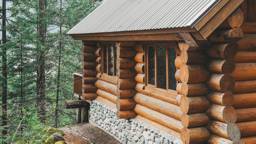

The last couple of years have disturbed many log-home dreams. Financing challenges, combined with setbacks to investment and retirement accounts and high building costs, have put some dreams on hold and seemingly dashed others. Even so, log-home dreams still live. To increase your own chances of success, make sure you don’t price yourself out of your dream.
When it comes to price, there is an 800-pound gorilla in the room by the name of “Square Footage.” Of all the things that affect whether you realize your dream, the size of your home has the greatest impact. While opting for less expensive countertops or choosing carpet over hardwood flooring might save hundreds of dollars, perhaps even a few thousand, downsizing will lower the cost of your home — often without sacrificing any part of your dream.
Trimming your home’s size isn’t about settling for less. It’s about understanding what each square foot of floor space in your home contributes to your lifestyle and cutting out those empty-calorie areas that may look appetizing but don’t really add substance.
From the 1970s through the mid-2000s, the average American home grew by more than 40 percent. At the same time, however, the average household size decreased. Lifestyles also changed, resulting in the decline of formal living and dining rooms, microwaves and prepared foods replacing home-cooked meals, and baths giving way to showers.
These changes should have reduced home sizes, but another trend took hold. Increasingly over the last 20 years, design decisions have been based on appearance rather than function. Gourmet kitchens flourished in homes whose owners cooked less, if at all. Terms like “wow-factor” replaced “comfortable” and “cozy.”
Having been an architectural photographer as well as a builder, I’m convinced that one of the reasons homes have grown so much has as much to do with home photography as with design. Interior photography often requires the use of wide-angle lenses, which have a tendency to make spaces appear larger. A well-designed bath of modest size can appear palatial when photographed with a wide-angle lens. Trying to actually build the expansive view shown in an interior photograph can lead to a room 30 to 50 percent larger than the actual space shown.
As you review possible designs, ask yourself two questions: “Will I use this space?” and “How often?” Weigh space against your lifestyle and look for the simplest solution that meets your needs. Instead of following the dictates of fashionable home design, step back and consider what you really want from your log home. Unless your dream is to awe your neighbors, build for yourself and the way you want to live. The result will be lower cost and greater comfort.
See also 6 Quick Steps to Becoming More Green & Eco-Friendly
Trim to Fit
Most people plan their home by laying out areas and then trying to fit their use of the space to its size. Typical homebuyers find a floor plan they like and then set about figuring out how to furnish each space.
Instead, start by listing the spaces you need and the furnishings you need to fit in those spaces. Consider uses for each area and look for spaces that might serve several uses. Use this list to sketch out potential floor plans. As you create spaces, size them according to the furnishings that belong in them. Allow enough room to move around furnishings, but don’t go overboard.
In most situations, three feet of clearance is adequate clearance, four to five feet is generous. For example, a dresser or chest needs space to stand comfortably with doors or drawers fully open. Depending on its location in the room, you might also want room for a person to pass behind someone standing in front of the dresser. In most cases, sketching the furnished room you want will result in a room meeting your wishes while requiring less area than if you simply used a stock floor plan.
Let your lifestyle influence room sizes and furnishings. For example, some people use a primary bedroom strictly for sleeping, while others may use it for relaxing, reading or watching television. The former may need space for a bed, nightstands and a dresser or two. The latter needs all of this plus space for a comfortable chair or small sofa and perhaps a TV. Inexpensive home-design software or templates in planning books can help here.
Scrutinize Kitchen Space
Kitchen space usually costs the most. Be realistic about how you live and how you will likely use your kitchen when laying out this room. By choosing appropriate cabinetry, countertops, floor coverings, appliances and lighting, for example, plus considering the basic cost of constructing the space, you might easily save $10,000 to $20,000 or more in this one room. Do you like to cook? Do you entertain a lot? Is your entertaining informal or formal? How often do you actually prepare old-fashioned meals with all of the slicing, dicing, chopping, blending and juggling of saucepans and skillets? If you don’t entertain much and only fix a full-blown meal on Thanksgiving, a large, fully equipped kitchen is mostly a money pit. Consider a smaller galley-type kitchen instead, perhaps one separated by walls from the living and dining area. Equipped with basic cabinetry and inexpensive countertops and floor coverings, this approach can save enough to pay for upgrades in other areas that correspond to the way you actually live.
If you do enjoy cooking and informal entertaining, you’ll want to spend more on your kitchen. Instead of closing it off, you may want to merge it into the great room, with an island or peninsula defining the space instead of walls. This arrangement lets busy chefs still be part of conversation.
See also 3 Ways to Light a Log Home
Analyze Bathrooms
Bathrooms usually represent the second-most expensive space in most homes, and the same guidelines apply as for kitchens. You’ll find a tremendous cost difference between an attractive functional bathroom and one designed solely to look like a photo spread in a design magazine. Fixtures, cabinetry, plumbing, labor, lighting and floor coverings typically add at least $4,000 to the cost of building the space.
Start by analyzing how you use bathrooms. Two working adults will probably use bath space very differently from how a retired couple would. Children, frequent overnight guests or a multigenerational household all introduce special considerations when designing baths. Strategic bathroom design can save thousands to tens of thousands of dollars.
Former clients of mine once insisted that each of their four daughters needed her own bedroom with private bath. This requirement alone added more than $20,000 to the cost of their home. Switching to two shared baths with double vanities could have saved at least $10,000. This, along with similar design requirements, inflated the cost estimate of their home by more than $100,000 — enough to cause them to abandon their project.
As you create spaces, ask yourself, “Is this space important enough that I would rather not have my log home than go without it?” Too often people abandon their entire log-home dream over some feature that may not contribute anything other than more space to heat, cool, clean and furnish.
Look at Shared Function
In addition to sizing areas according to their use, look for ways rooms can do double or even triple duty. An infrequently used but necessary home office might double as a TV or craft room. A peninsula or island in an open kitchen can provide counterspace that serves both for meal preparation and casual dining. A bath with entrances from a hallway and a bedroom can serve as a powder room for daytime public use and a private bath for overnight guests.
Great rooms are the granddaddy of all multipurpose spaces. They combine living, dining and family rooms into a single area. Done right, a great room saves square footage and reduces furnishing costs. But beware! Too easily the great room can grow to be larger than the area occupied by the individual spaces it combines. An auditorium-like great room may be impressive to look at, but it is generally not pleasant or comfortable to live in.
See also The Pros and Cons of Living in a Ranch Home
Think Beyond Size
The benefits of square-foot consciousness aren’t limited to the size of your home. Building components can also contribute to the cost. Each square foot of floor, wall and roof area has a cost associated with it that depends on the materials it includes. For example, a square foot of log wall may have a material cost of $15 to $20 for logs, sealants, fasteners and finish coatings. A square foot of high-efficiency window can carry a price tag of more than $50. This means that each square foot of window can add $30 or more to the overall cost of your home. This may not seem like much, until you apply this arithmetic to the vast expanses of glass so popular among log-home enthusiasts. A 20-by-20-foot window wall can easily add $12,000 to the overall cost of your home. A 12-foot glass door unit set in the wall may not offer quite the expanse of glass, but it will cost about $8,000 less.
Windows are an especially sensitive price point. They affect energy costs greatly. Poorly placed windows can lead to overheating in summer, which can raise cooling costs substantially. Windows don’t offer much insulation value, leading to higher heating costs and perhaps even a need to upsize the heating system. As energy costs rise and building codes call for greater energy efficiency, window selection and placement will become more important in overall new home costs. The most efficient windows currently available have square-foot costs two to three times the figures I used above.
Helpful Pruning Tools
When it comes to pruning square footage, several tools can help. Graph paper, an architect’s rule and a tape measure offer the most basic assistance. Measure existing furnishings so you can sketch them accurately on scaled room layouts. Most people don’t work with dimensions regularly. Guessing at sizes and spaces can lead to large errors.
Many art or drafting supply stores carry plastic templates of furnishings, ranging from nightstands to automobiles, in popular scales. Use these to simplify preparing room layouts. If you prefer, step up to inexpensive computer software that includes libraries of home furnishings.
Over the years, clients have often seen reducing square footage as sacrificing part of their dream. I’ve always responded that trimming size isn’t about giving up what you want. It’s about not letting the cost of what matters less preventing you from achieving what matters the most: making your log-home dream come true.
Jim Cooper, a former general contractor, is the author of Log Homes Made Easy and a LEED Accredited Professional who consults in energy efficient and sustainable building.











